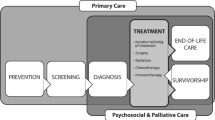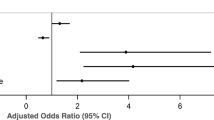Abstract
Many individuals who use tobacco will continue to smoke after a cancer diagnosis and throughout treatment. This study aims to better understand cancer patient preferences to learn about smoking cessation. All new patients seen at Princess Margaret Cancer Centre between 1 January 2014 and 30 June 2015 were asked to complete the Combined Tobacco History Survey as part of standard new patient assessments. Smoking status, second hand smoke exposure, years smoked, family support, cessation preferences, demographic and tumour details were collected. Multivariable regression assessed factors associated with smoking cessation educational preferences. Nine thousand and one hundred ten patients completed the survey. One thousand and six hundred ninety-one were current smokers (17 %) of which 43 % were female and median age was 57 years (range 18–95). One thousand and two hundred thirty-eight (73 %) were willing to consider quitting and 953 (56 %) reported a readiness to quit next month. Patients were most interested in pamphlets (45 %) followed by telephone support (39 %), speaking with a healthcare professional (29 %), website (15 %), support group (11 %) and speaking with successful former smokers (9 %). Younger patients (≤45 years) preferred receiving smoking cessation education over the telephone (50 %; p < 0.001), while older patients (46–65 years and >65 years) preferred smoking education to be provided in pamphlets (43 and 51 %, respectively; p = 0.07). In multivariable analyses, older patients were more likely to prefer pamphlets than younger patients OR 1.11 (95 % CI 1.01–1.23; p = 0.03). Older cancer patients preferred to receive smoking cessation education through pamphlets and younger patients preferred the telephone. Tailored provision of cessation education resources for cancer patients is warranted.

Similar content being viewed by others
References
Canada. 2013. Chronic Disease Risk Factor Analysis PHAo. http://www.phac-aspc.gc.ca/cd-mc/atlas/index-eng.php. Accessed.
Makomaski Illing EM, Kaiserman MJ (2004) Mortality attributable to tobacco use in Canada and its regions, 1998. Can J Public Health 95(1):38–44
Holford TR, Meza R, Warner KE, Meernik C, Jeon J, Moolgavkar SH, Levy DT (2014) Tobacco control and the reduction in smoking-related premature deaths in the United States, 1964–2012. JAMA 311(2):164–171. doi:10.1001/jama.2013.285112
Mokdad AH, Marks JS, Stroup DF, Gerberding JL (2004) Actual causes of death in the United States, 2000. JAMA 291(10):1238–1245. doi:10.1001/jama.291.10.1238
Warren GW, Kasza KA, Reid ME, Cummings KM, Marshall JR (2013) Smoking at diagnosis and survival in cancer patients. Int J Cancer 132(2):401–410. doi:10.1002/ijc.27617
USDoHaH, Services (1990) The health benefits of smoking cessation: a report of the surgeon general, ed. Centers for Disease Control and Prevention U.S. Department of Health and Human Services, National Center for Chronic Deisease Prevention and Health Promotion, Office on Smoking and Health, Atlanta
USDoHaH, Services (2014) The health consequences of smoking: 50 years of progress. A report of the surgeon general., ed. Centers for Disease Control and Prevention U.S. Department of Health and Human Services, National Center for Chronic Deisease Prevention and Health Promotion, Office on Smoking and Health, Atlanta
Toll BA, Brandon TH, Gritz ER, Warren GW, Herbst RS, Aacr Subcommittee on Tobacco, and Cancer (2013) Assessing tobacco use by cancer patients and facilitating cessation: an American Association for Cancer Research policy statement. Clin Cancer Res 19(8):1941–1948. doi:10.1158/1078-0432.CCR-13-0666
Mayer DK, Carlson J (2011) Smoking patterns in cancer survivors. Nicotine Tob Res 13(1):34–40. doi:10.1093/ntr/ntq199
Bellizzi KM, Rowland JH, Jeffery DD, McNeel T (2005) Health behaviors of cancer survivors: examining opportunities for cancer control intervention. J Clin Oncol 23(34):8884–8893. doi:10.1200/JCO.2005.02.2343
Eng L, Su J, Qiu X, Palepu PR, Hon H, Fadhel E, Harland L et al (2014) Second-hand smoke as a predictor of smoking cessation among lung cancer survivors. J Clin Oncol 32(6):564–570. doi:10.1200/JCO.2013.50.9695
Walker MS, Vidrine DJ, Gritz ER, Larsen RJ, Yan Y, Govindan R, Fisher EB (2006) Smoking relapse during the first year after treatment for early-stage non-small-cell lung cancer. Cancer Epidemiol Biomarkers Prev 15(12):2370–2377. doi:10.1158/1055-9965.EPI-06-0509
Gritz ER, Nisenbaum R, Elashoff RE, Holmes EC (1991) Smoking behavior following diagnosis in patients with stage I non-small cell lung cancer. Cancer Causes Control 2(2):105–112
Ostroff JS, Jacobsen PB, Moadel AB, Spiro RH, Shah JP, Strong EW, Kraus DH, Schantz SP (1995) Prevalence and predictors of continued tobacco use after treatment of patients with head and neck cancer. Cancer 75(2):569–576
Browman GP, Wong G, Hodson I, Sathya J, Russell R, McAlpine L, Skingley P, Levine MN (1993) Influence of cigarette smoking on the efficacy of radiation therapy in head and neck cancer. N Engl J Med 328(3):159–163. doi:10.1056/NEJM199301213280302
Gritz ER, Fingeret MC, Vidrine DJ, Lazev AB, Mehta NV, Reece GP (2006) Successes and failures of the teachable moment: smoking cessation in cancer patients. Cancer 106(1):17–27. doi:10.1002/cncr.21598
Jacobs-Lawson JM, Schumacher MM, Hughes T, Arnold S (2009) The relationship between lung cancer patients’ educational level and evaluation of their treatment information needs. J Cancer Educ 24(4):346–350. doi:10.1080/08858190902876601
Cooley ME, Sarna L, Kotlerman J, Lukanich JM, Jaklitsch M, Green SB, Bueno R (2009) Smoking cessation is challenging even for patients recovering from lung cancer surgery with curative intent. Lung Cancer 66(2):218–225. doi:10.1016/j.lungcan.2009.01.021
Schnoll RA, Rothman RL, Newman H, Lerman C, Miller SM, Movsas B, Sherman E et al (2004) Characteristics of cancer patients entering a smoking cessation program and correlates of quit motivation: implications for the development of tobacco control programs for cancer patients. Psychooncology 13(5):346–358. doi:10.1002/pon.756
Cooley ME, Emmons KM, Haddad R, Wang Q, Posner M, Bueno R, Cohen TJ, Johnson BE (2011) Patient-reported receipt of and interest in smoking-cessation interventions after a diagnosis of cancer. Cancer 117(13):2961–2969. doi:10.1002/cncr.25828
Garces YI, Hays JT (2003) Tobacco dependence: why should an oncologist care? J Clin Oncol 21(9):1884–1886. doi:10.1200/JCO.2003.07.102
Sarna L, Wewers ME, Brown JK, Lillington L, Brecht ML (2001) Barriers to tobacco cessation in clinical practice: report from a National Survey of Oncology Nurses. Nurs Outlook 49(4):166–172. doi:10.1067/mno.2001.115448
Sarna LP, Brown JK, Lillington L, Rose M, Wewers ME, Brecht ML (2000) Tobacco interventions by oncology nurses in clinical practice: report from a national survey. Cancer 89(4):881–889
Park ER, Japuntich SJ, Rigotti NA, Traeger L, He Y, Wallace RB, Malin JL, Zallen JP, Keating NL (2012) A snapshot of smokers after lung and colorectal cancer diagnosis. Cancer 118(12):3153–3164. doi:10.1002/cncr.26545
Sheffer C, Stitzer M, Landes R, Brackman SL, Munn T (2013) In-person and telephone treatment of tobacco dependence: a comparison of treatment outcomes and participant characteristics. Am J Public Health 103(8):e74–82. doi:10.2105/AJPH.2012.301144
Sium A, Giuliani M, Papadakos J (2015). The persistence of the pamphlet: on the continued relevance of the health information pamphlet in the digital age. J Cancer Educ doi: 10.1007/s13187-015-0948-3.
Milne RA, Puts MT, Papadakos J, Le LW, Milne VC, Hope AJ, Catton P, Giuliani ME (2015) Predictors of high eHealth literacy in primary lung cancer survivors. J Cancer Educ 30(4):685–692. doi:10.1007/s13187-014-0744-5
Neter E, Brainin E (2012) eHealth literacy: extending the digital divide to the realm of health information. J Med Internet Res 14(1):e19. doi:10.2196/jmir.1619
Hanna N, Mulshine J, Wollins DS, Tyne C, Dresler C (2013) Tobacco cessation and control a decade later: American society of clinical oncology policy statement update. J Clin Oncol 31(25):3147–3157. doi:10.1200/JCO.2013.48.8932
Goldstein AO, Ripley-Moffitt CE, Pathman DE, Patsakham KM (2013) Tobacco use treatment at the U.S. National Cancer Institute’s designated Cancer Centers. Nicotine Tob Res 15(1):52–58. doi:10.1093/ntr/nts083
Karam-Hage M, Cinciripini PM, Gritz ER (2014) Tobacco use and cessation for cancer survivors: an overview for clinicians. CA Cancer J Clin 64(4):272–290. doi:10.3322/caac.21231
Warren GW, Marshall JR, Cummings KM, Toll BA, Gritz ER, Hutson A, Dibaj S et al (2013) Addressing tobacco use in patients with cancer: a survey of American Society of Clinical Oncology members. J Oncol Pract 9(5):258–262. doi:10.1200/JOP.2013.001025
Gritz ER, Vidrine DJ, Fingeret MC (2011) Tobacco dependence and its treatment. In: Rosenberg SA (ed) Devite, Hellman, and Rosenberg’s Cancer: Principles and Practice of Oncology. Lippincott Williams & Wilkins, a Wolters Kluwer Business, Philadelphia, p 529–542
USDoHaH, Services (2008) Treating tobacco use and dependence: 2008 Update, ed. Quality AfHRa.
Author information
Authors and Affiliations
Corresponding author
Rights and permissions
About this article
Cite this article
Sampson, L., Papadakos, J., Milne, V. et al. Preferences for the Provision of Smoking Cessation Education Among Cancer Patients. J Canc Educ 33, 7–11 (2018). https://doi.org/10.1007/s13187-016-1035-0
Published:
Issue Date:
DOI: https://doi.org/10.1007/s13187-016-1035-0




